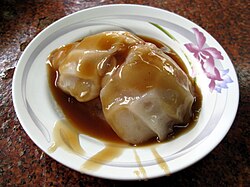Ba-wan
[dummy-text]
Ba-wan
Jump to navigation
Jump to search
This article includes a list of references, but its sources remain unclear because it has insufficient inline citations. (March 2016) (Learn how and when to remove this template message) |
 Ba-wan served with A-jit | |
| Type | Dumpling |
|---|---|
| Course | Dim sum |
| Place of origin | Taiwan |
| Main ingredients | Dough (corn starch, sweet potato starch, rice flour), pork, chicken, bamboo shoots, shiitake mushrooms |
| |
Ba-wan (Chinese: 肉圓; pinyin: ròuyuán; Wade–Giles: jou4-yüan2; Pe̍h-ōe-jī: bah-ôan; literally: "meat circle") is a Taiwanese street food, consisting of a 6–8 cm diameter disk-shaped translucent dough made of sweet potato starch[1][2] filled with a savory stuffing and served with a sweet and savory sauce. The stuffing varies widely according to different regions in Taiwan, but usually consists of a mixture of pork, bamboo shoots, and shiitake mushrooms.[3]Changhua-style ba-wan is considered to be the "standard" ba-wan as it is the most famous and most widely imitated of all styles of ba-wan.
The term "ba-wan" is a non-standard romanization derived from Taiwanese Hokkien. In the township of Lukang, Changhua County, ba-wan are known as bahhoe (肉回; ròuhuí; bah-hôe; "meat return") because they take on the block-like shape of the character 回.
The gelatinous dough is made of a combination of corn starch, sweet potato starch, and rice flour, which gives it its chewy, sticky, and gelatinous texture and a greyish translucent hue. Ba-wan are initially cooked by steaming; however, they may also be served after being deep fried to give them a "skin" or gently poached in oil to heat them without drying them out.
History[edit]
It is believed that ba-wan were first prepared in the Beidou township of Changhua County by a scribe by the name of Fan Wan-chu (范萬居; Fàn Wànjū) as food for disaster relief, when the region was struck by heavy floods in 1898.[4] Since then, ba-wan had spread to different regions of Taiwan and is now considered by many as a national food, and can be found in most night markets in Taiwan. Their form makes them relatively easy to pre-make and store. Like potstickers or steamed buns, they can be quickly heated again in oil before serving.
See also[edit]
- List of dumplings
 Food portal
Food portal
References[edit]
^ Behnke, A. (2007). Taiwan in Pictures. Visual Geography (Lerner) Series. Twenty-First Century Books. p. 53. ISBN 978-0-8225-7148-3. Retrieved 5 November 2016..mw-parser-output cite.citationfont-style:inherit.mw-parser-output qquotes:"""""""'""'".mw-parser-output code.cs1-codecolor:inherit;background:inherit;border:inherit;padding:inherit.mw-parser-output .cs1-lock-free abackground:url("//upload.wikimedia.org/wikipedia/commons/thumb/6/65/Lock-green.svg/9px-Lock-green.svg.png")no-repeat;background-position:right .1em center.mw-parser-output .cs1-lock-limited a,.mw-parser-output .cs1-lock-registration abackground:url("//upload.wikimedia.org/wikipedia/commons/thumb/d/d6/Lock-gray-alt-2.svg/9px-Lock-gray-alt-2.svg.png")no-repeat;background-position:right .1em center.mw-parser-output .cs1-lock-subscription abackground:url("//upload.wikimedia.org/wikipedia/commons/thumb/a/aa/Lock-red-alt-2.svg/9px-Lock-red-alt-2.svg.png")no-repeat;background-position:right .1em center.mw-parser-output .cs1-subscription,.mw-parser-output .cs1-registrationcolor:#555.mw-parser-output .cs1-subscription span,.mw-parser-output .cs1-registration spanborder-bottom:1px dotted;cursor:help.mw-parser-output .cs1-hidden-errordisplay:none;font-size:100%.mw-parser-output .cs1-visible-errorfont-size:100%.mw-parser-output .cs1-subscription,.mw-parser-output .cs1-registration,.mw-parser-output .cs1-formatfont-size:95%.mw-parser-output .cs1-kern-left,.mw-parser-output .cs1-kern-wl-leftpadding-left:0.2em.mw-parser-output .cs1-kern-right,.mw-parser-output .cs1-kern-wl-rightpadding-right:0.2em
^ Wong, Maggie Hiufu (24 July 2015). "40 Taiwanese foods we can't live without". CNN. Retrieved 5 November 2016.
^ "A beginner's guide to Taiwanese food in London: the best restaurants". Evening Standard. 6 May 2015. Retrieved 5 November 2016.
^ Han Cheung (5 August 2018). "Taiwan in Time: Deadly waters and their legends". Taipei Times. Retrieved 5 August 2018.
林明德 (2002). 彰化縣飲食文化 (in Chinese). Changhua City: Changhua County Cultural Affairs Bureau. ISBN 9789570101263.
Categories:
- Taiwanese cuisine
- Dumplings
(window.RLQ=window.RLQ||).push(function()mw.config.set("wgPageParseReport":"limitreport":"cputime":"0.384","walltime":"0.497","ppvisitednodes":"value":1234,"limit":1000000,"ppgeneratednodes":"value":0,"limit":1500000,"postexpandincludesize":"value":75568,"limit":2097152,"templateargumentsize":"value":719,"limit":2097152,"expansiondepth":"value":14,"limit":40,"expensivefunctioncount":"value":1,"limit":500,"unstrip-depth":"value":1,"limit":20,"unstrip-size":"value":12529,"limit":5000000,"entityaccesscount":"value":0,"limit":400,"timingprofile":["100.00% 396.251 1 -total"," 29.40% 116.502 1 Template:Transl"," 22.04% 87.317 1 Template:Reflist"," 16.73% 66.290 2 Template:Cite_book"," 14.17% 56.145 1 Template:More_footnotes"," 13.70% 54.295 1 Template:Infobox_prepared_food"," 11.56% 45.788 1 Template:Infobox"," 11.45% 45.361 6 Template:Navbox"," 9.31% 36.898 1 Template:Ambox"," 6.68% 26.477 1 Template:Taiwanese_cuisine"],"scribunto":"limitreport-timeusage":"value":"0.214","limit":"10.000","limitreport-memusage":"value":13235635,"limit":52428800,"cachereport":"origin":"mw1250","timestamp":"20181227115159","ttl":1900800,"transientcontent":false);mw.config.set("wgBackendResponseTime":101,"wgHostname":"mw1273"););


